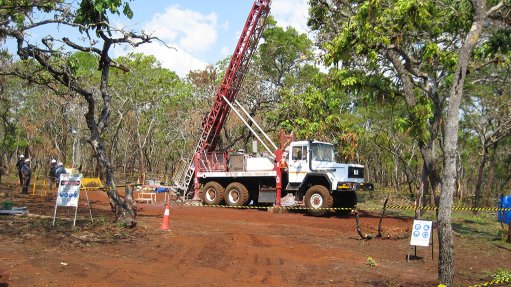
MINING OPERATION IMX Resources aims to increase nickel sulphide deposit at Ntaka Hill
Base metals exploration company IMX Resources is aiming to increase the current nickel sulphide deposit and establish a world-class nickel project at its Ntaka Hill nickel sulphide project, in south-east Tanzania, through the ongoing Nachingwea exploration project, says IMX Resources MD Gary Sutherland.
The Nachingwea property, which is highly prospective for nickel, copper, gold and other minerals, including graphite, is the subject of a joint venture agreement between IMX Resources and global resources company MMG Exploration. Under the agreement, MMG can earn up to a 60% interest in the Nachingwea property by spending up to $60-million over a five-year period. However, the company is required to spend $10-million during Stage 1 of the project to earn an initial 15% interest.
Sutherland says MMG is rapidly approaching this $10-million requirement, adding that no further drilling is likely to be carried out.
MMG’s exploration programme, which first started in 2013, has included geophysics, regional soil geochemistry surveys and reverse-circulation (RC) drilling campaigns.
However, Sutherland tells Mining Weekly IMX Resources is focusing on a complete review of the Nachingwea property, in light of the recently identified Kishugu gold target, within the Nachingwea property, and the world’s current focus on East Africa as a graphite exploration destination.
He adds that, owing to higher-than-expected RC drilling costs, additional surface works and equipment-related issues, only 1.121 m of the planned exploration programme of regional drilling has been completed. “We are not sure when the project could possibly be completed, as MMG still has to confirm whether it will progress to Phase 2 of the project,” says Sutherland.
He adds that MMG's exploration work, specifically for large-scale nickel sulphide mineralisation at depth, was largely unsuccessful and it is therefore unlikely that MMG will indeed proceed to Phase 2 of the joint venture.
Nevertheless, he adds that, overall, the exploration programme has still achieved a lot, as mineralisation was intersected in several boreholes. Sutherland adds that Ntaka Hill remains a valuable nickel project, with several untested targets and longer-term potential.
IMX also remains enthusiastic about the prospectivity of its Nachingwea property, as there is still a substantial nickel sulphide resource at Ntaka Hill, an enormous gold anomaly at Kishugu and graphite mineralisation on the property, which was recently announced.
“Our future strategy will include testing several structural targets that may host structurally remobilised bodies of mineralisation,” says Sutherland, adding that IMX Resources still regards the development of Ntaka Hill and the broader Nachingwea property as important factors that will contribute to the significant expansion of the company’s current mineral resources inventory.
Further, the company stands to inherit a substantial geochemical, geophysical and drilling database for Ntaka Hill and the broader Nachingwea property.
“The current measured and indicated resource at Ntaka Hill is 20.3-million tonnes at 0.58% nickel and 0.13% copper for 117 880 t of contained nickel, with an inferred resource of 35.9- million tonnes at 0.66% nickel and 0.14% copper for 238 500 t of contained nickel.
“In addition, there are several other drill- defined nickel sulphide deposits, such as P Zone and Ntaka Kati, at Ntaka Hill,” adds Sutherland.
He concludes that, because of all the benefits that will come from the exercise, IMX Resources is likely to carry on with the exploration programme, even if MMG decides to pull out of the joint venture.